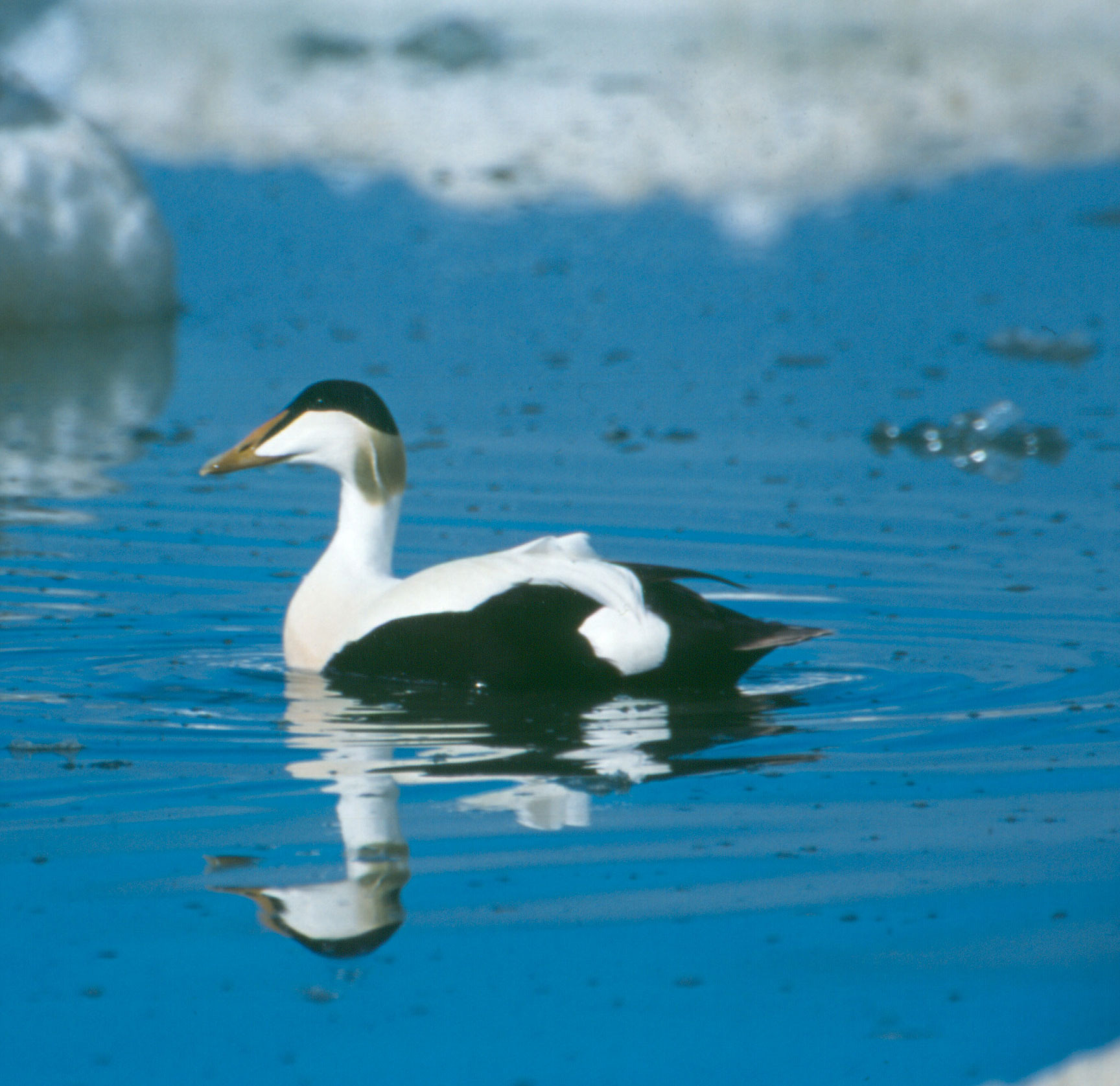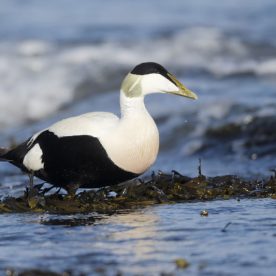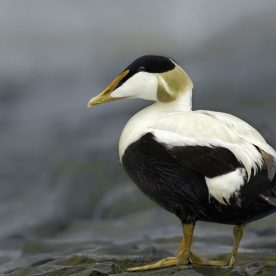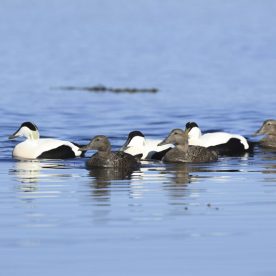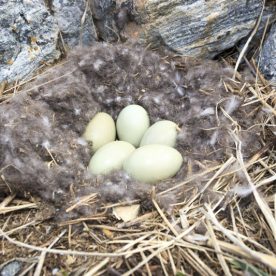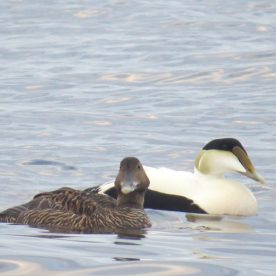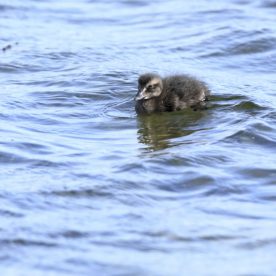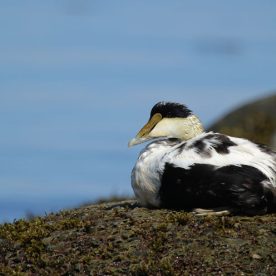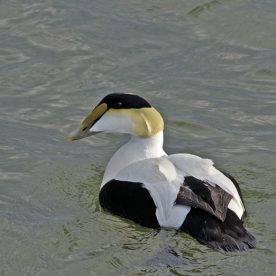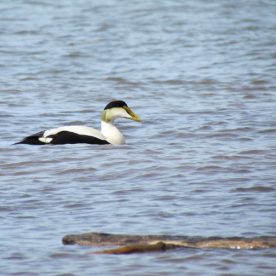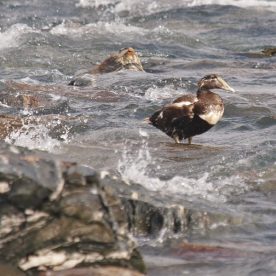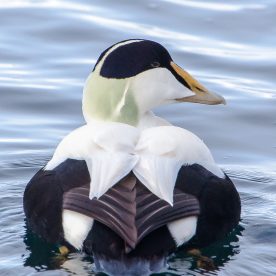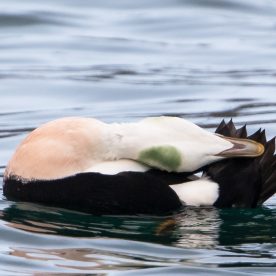Description
The Common Eider Somateria mollissima is the largest duck in the northern hemisphere. It weighs an average of 1 800 g, but its weight can vary from 850 to 3 025 g depending on race, sex, and time of year. There are four Common Eider races in North America; subtle differences in body size and bill structure distinguish each race from the other.
The plumage of the Common Eider varies considerably. It passes through several stages while the bird is growing to maturity, and after the bird reaches adulthood at about three years old, the plumage alternates between two colours each year as a result of moulting, or the replacement of old feathers with new. In addition, the male’s plumage differs from the female’s.
Between the ages of three weeks and three years, male Common Eiders moult their feathers eight times, changing their colour from a juvenile blackish brown to an adult olive-brown and white in winter and a striking black and white, with a small area of light emerald green on the back and sides of the head, during the breeding season. Changes in female plumage are less dramatic: from a juvenile blackish brown, the duck becomes rusty-to-tan. The female’s summer colours provide good camouflage in the vegetation and rocks of the offshore islands on which she breeds.
Common Eiders can live 20 years, one of the longest lifespans among sea ducks. However, the expected lifespan for eider populations which are heavily harvested may be much shorter.
Signs and sounds
Ducklings utter a number of sounds, ranging from a high-pitched note of contentment, which they give especially when they are feeding in the water, to a distress call—a monosyllabic piping.
When they are alarmed, adult Common Eiders emit a series of hoarse kor-korr-korr notes. When courting, drakes give a haunting call much like the cooing of pigeons, which can travel great distances across water on calm days.
Females are less vocal than males. They produce a series of throaty calls during courtship and feeding and an abrupt cluck-cluck-cluck when defending their ducklings from avian predators such as herring gulls.
Habitat and Habits
Of all sea ducks, the Common Eider is the most closely tied to marine habitat. It lives in arctic and subarctic coastal marine areas, where it frequents coastal headlands, offshore islands, skerries, and shoals. The Common Eider rarely leaves the water in the winter, and some races remain as far north as there is open water.
The four races of Common Eiders in North America have different breeding ranges. The southern race Somateria mollissima dresseri breeds from Maine to Hamilton Inlet on the Labrador coast; the northern race Somateria mollissima borealis breeds from northern Labrador to Ellesmere Island in the eastern Canadian Arctic; the Hudson Bay race Somateria mollissima sedentaria remains all year within Hudson Bay; and the Pacific race Somateria mollissima v-nigra breeds from Coronation Gulf in the MacKenzie District of the Northwest Territories to the south side of the Alaskan peninsula. Three subspecies are found outside North America: one in northwest Europe, one in Iceland and a third in the Faeroe Islands north of Great Britain.
The Common Eider belongs to the sea duck tribe (Mergini), which contains closely related ducks, all of which use marine habitats to some degree. The King Eider Somateria spectabilis, Spectacled Eider Somateria fischeri, and Common Eider all belong to the same genus, and hybridization is known to occur between Common and King Eiders.
Eider ducks are gregarious, travelling and feeding in flocks numbering from tens to thousands.
Unique characteristics
Young Common Eiders often benefit from the care of “aunts,” which are nonbreeding females. These “aunts” gather around nests containing hatching eggs or newly hatched young and accompany the ducklings to the water with their mother and help to protect the young from predators.
Another noteworthy practice is the Common Eiders’ habit of gathering in compact flocks at night, sometimes offshore, at other times in the protection of a headland or cove. Folklore claims that under very cold conditions some eiders move around the outer ring of the flock in order to keep the water from freezing. Although this behaviour has not been documented by scientists, it is known that in winter when the temperature drops eiders protect themselves in other ways. They minimize their energy expenditure by becoming inactive, not feeding and, presumably to insulate themselves, gathering in groups so dense that individual ducks cannot be counted.
Range
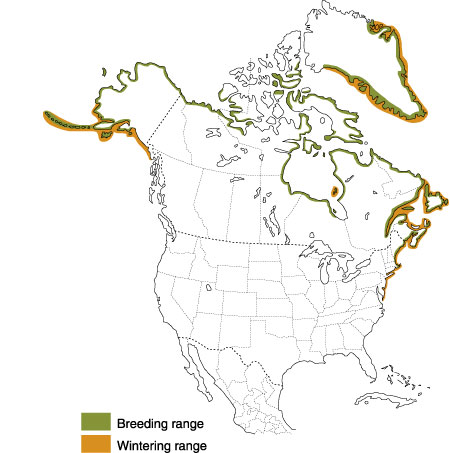
Common Eiders breed along much of the coast of northern North America, south to Maine in the east and south to the Alaska Peninsula in the west. In winter the various races shift southward, even as far as Florida on the eastern seaboard and to the coast of Washington in the Pacific. However, the bulk of the Atlantic coast eiders winter in Newfoundland and Labrador and on Cape Cod, Maine, and most of the Pacific eiders winter in the Aleutian Islands in Alaska.
The four races of Common Eider that breed in Canada follow a wide range of migration patterns. Most eiders migrate in spring and fall, some travelling long distances, others short; some populations remain in the same area year-round.
Common Eiders that migrate in spring travel rapidly. Most birds fly along the coast, though some individuals are known to cross over significant tracts of land, such as the Nova Scotia–New Brunswick border region or the isthmus of the Avalon Peninsula on the island of Newfoundland. They travel in compact flocks of a few to thousands, flying low to the water and travelling at speeds of 60 to 70 km per hour.
Fall and winter migration is slower and more leisurely. During this migration, eiders rarely cross land, usually only flying over projecting points of land or headlands, and then only under certain weather conditions, such as snow and onshore winds. The eiders of the inner Gulf of St. Lawrence are an exception, many of them moving first southwest into the St. Lawrence estuary a little downstream of Quebec City and then flying over much of the state of Maine.
Eiders begin to migrate south in the late fall. The timing is largely influenced by freeze-up and by the growth of pack ice, which occurs progressively later as one proceeds south and is a more important influence in the northwest Atlantic than elsewhere. There is generally a supplanting effect: birds from farther north replace those that have bred and migrated south.
In June and July, males, or drakes, and nonbreeders make moult migrations to replace their worn-out plumage with new plumage in an area where they will be protected from weather and predators. They often move several hundred kilometres north from their breeding areas. During the moult, the eiders are unable to fly for three to four weeks, and the ducks lose weight as energy is used to grow new feathers. By mid-September, the drakes have resumed flight and are ready to return to the wintering grounds. However, they travel separately from the females and young, and often arrive later at the wintering grounds than these two groups, even though the adult females moult later, in August and September.
Feeding
Eiders feed during the day by diving to the bottom in waters from 3 to 20 m deep to take mussels, clams, scallops, sea urchins, starfish, and crabs, which are swallowed whole and crushed in the large gizzard.
In winter, when daylight is short, more than half the daytime hours are spent in feeding. The ducks feed in shoal waters off headlands and offshore islands and skerries. Flocks move together at the same rate, the ducks at the front of a flock diving first and the rest following sequentially. After 15 to 30 minutes of intensive feeding, flocks move offshore to rest, preen, and digest the contents of the gullet. The feeding sequence is then repeated.
During spring migration, and when the eider ducks arrive near their breeding places, much time is spent feeding, and the birds accumulate fat. These stores are particularly important for the breeding females, or hens, which rely on the reserves through the incubation period. Unlike many ducks, the hen does not feed once she starts sitting on her eggs.
The young apparently eat insects during their first week of life.
Breeding
Eiders return to the breeding islands along the northern coasts as soon as shorefast ice or pack ice starts to dissipate. Many eider ducks are paired when they arrive on the breeding grounds, although some pairing occurs there. Some races remain paired for several years, others do not. Courtship is very intense in spring, with males making displays for the females which include the upward tossing of the head, cooing, neck-stretching and wing-flapping. Courtship continues after pairing in order to maintain pair bonds.
Some female eiders may breed in their second year of life, but males do not breed until they are three years old. Many females will not breed in some years. Common Eiders breed mainly on small offshore marine islands or isolated spits and points that are free of mammalian predators. Within a couple of weeks of arriving at the breeding grounds, the birds make prospecting flights and visits to choose a suitable nesting place. Often females will use the same nesting site for a number of years, while others choose new nest sites each year. They nest in early summer in dense colonies of tens to 10 000 or more; nesting starts progressively later as one proceeds farther north. There is one brood per season.
Only the female prepares the nest. In some races, the male stays with the female for a while; in others, he does not. When he remains, the male defends the female from other eiders and from gulls and ensures that she does not mate with other males.
The female begins laying the eggs a couple of days after the nest is ready. There are usually four or five eggs per nest, and generally, one egg is laid per day. When the second or third egg has been laid, the female lines her nest with down plucked from her body. While laying the egges, some females will leave the nesting colony, possibly to feed before they return to the nest to incubate, or sit on the eggs, continuously. Once incubation begins, the female only leaves the nest for a little as five minutes every two or three days to drink, but not to eat. During early egg-laying, if the male is still in the vicinity, he accompanies the female on her breaks. By mid-incubation, most males have left the colony on their moult migrations. Incubation lasts from 21 to 24 days, and about 50 to 70 percent of the eggs hatch successfully.
The downy newborns leave the nest within 24 hours, and they feed themselves. Within one hour of entering the water, they can dive competently. Young first fly when they are 60 days old. Generally, few survive to fly; many are lost to predators, exposure, or starvation in their first week of life. In good years, one duckling per adult pair may survive for the fall flight. On the other hand, adults are often long-lived, and estimated annual survival rates vary from 80 to 95 percent. This low reproductive success, which is compensated by high adult survival, is very characteristic of eiders and other sea ducks such as scoters and Long-tailed Ducks. Most other ducks breed more successfully but lose 40 to 50 percent of adults each year.
The mother’s relationship with her ducklings ends when she leaves for the moult migration in the autumn. In the fall migration, groups of young may travel together and arrive before the adults on the winter range.
Conservation
The main predators of Common Eiders are large gulls, ravens, American crows, and jaegers, which prey on the eggs and the downy young. Because they nest mostly on small islands, Common Eiders have few mammalian predators. Sometimes arctic foxes or red foxes may inflict some damage, and if polar bears come ashore at nesting colonies, they can destroy all the nests and kill many nesting females.
Common Eiders also fall victim to starvation in years of low food supply, and sometimes brooding females will die of starvation during the incubation period when they do not leave their nests.
Hunting has taken a heavy toll. Before the introduction of hunting regulations, breeding stock of Common Eider were greatly reduced, to the point of some local extinction in widely scattered breeding areas. Fortunately, this bird responds well to adequate protection, and not only has reoccupied lost areas but also, in recent decades, has extended its breeding range in western Europe, the British Isles, Atlantic Canada, and elsewhere.
Such recoveries in eastern North America began quite soon after the enactment in 1916 of the Migratory Birds Convention between Canada and the United States, which limits hunting of migratory birds. The Common Eider was given special recognition at that time because of the greatly diminished breeding stocks along the eastern seaboard. Eider ducks in most areas recovered dramatically at rates of up to 12 percent per year; for example, in Maine, the number of nests increased from fewer than 100 in one colony in 1910 to more than 20 000 nests in over 75 colonies by 1970. Scientists have not determined how many Common Eiders live in Canada today.
In Newfoundland and southern Labrador, breeding stocks have yet to recover to any extent. This is partly because, until 1949, when Newfoundland entered Confederation, these areas were not bound by the provisions of the Migratory Birds Convention Act and partly because of the lack of adequate public education and enforcement of hunting regulations under the Act. Illegal hunting and taking of eggs during the spring and early fall, when the local breeding population is present, has kept the number of local breeders low.
Another cause for concern is the harvest in southwestern Greenland of the wintering northern Common Eider (S. m. borealis), which breeds in the eastern Arctic of Canada and in west Greenland. It is thought that the harvest may not be sustainable and that the population there may be in decline.
In addition, the Pacific race of common eider (S. m. v-nigra) has experienced dramatic population declines since the 1980s for unknown reasons.
In Canada, recreational hunting of eider is permitted during a winter hunting season, even in Newfoundland and southern Labrador. This is because the eiders present on the Newfoundland and Labrador coasts and in the Gulf of St. Lawrence during the winter are not local breeders: they belong to larger Arctic breeding populations.
Increased focus on public education and enforcement and the promotion of other uses of eiders, such as the harvesting of down, is laying the groundwork for a recovery of breeding stocks. Eider down is one of the lightest and most effective insulators known. It commands high prices on the world market and is used in products such as parkas, sleeping bags, and comforters. The down can be collected without damaging the ducks or their eggs and nests. Eider down harvesting occurs in the Gulf of St. Lawrence and in Nunavut, and recently there has been interest in the potential of this activity in Newfoundland and Labrador. In Iceland where there are significant eider down farms and the eider down harvest is a multimillion dollar industry, eiders are protected against hunting all year around.
Resources
Online resources
Sea Duck Joint Venture (a joint venture under the North American Waterfowl Management Plan)
Audubon Field Guide, Common Eider
Print resources
Bellrose, F.C. 1976. Ducks, geese and swans of North America. Stackpole Books. Harrisburg, Pennsylvania.
Godfrey, W.E. 1986. The birds of Canada. Revised edition. National Museums of Canada, Ottawa.
Goudie, R. I., G. J. Robertson, and A. Reed. 2000. Common Eider (Somateria mollissima). In A. Poole and F. Gill, editors. The Birds of North America, no. 546. The Academy of Natural Sciences, Philadelphia, Pennsylvania.
Palmer, R.S. 1976. Handbook of North American birds. Volume 3. Yale University Press, New Haven, Connecticut.
Reed, A., editor. 1986. Eider ducks in Canada. Report Series No. 47. Canadian Wildlife Service, Ottawa.
© Her Majesty the Queen in Right of Canada, represented by the Minister of the Environment, 1973, 1989, 2003, 2005. All rights reserved.
Catalogue number CW69-4/72-2003E-IN
ISBN 0-662-34278-X
Text: Ian Goudie
Revision: Ian Goudie, 1996; Grant Gilchrist, 2003
Editing: Maureen Kavanagh, 2003, 2005
Photos: Grant Gilchrist



